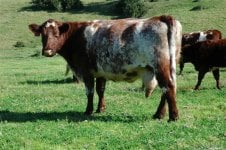Duncraggan
Well-known member
- Joined
- Jun 2, 2012
- Messages
- 821
I don't select for udders in my herd, but, the cows cull themselves.
The cow pictured below has never been milked out after calving. I don't believe in it,and therefore haven't done it since an old-timer told me he believes it makes them produce even more milk! Once the calf has suckled for the first two days it gets put out with the rest of the recent calvers.
She has produced an above average calf every year since 2007 and that is why she is still around. That said, all her progeny have been sold so as not to breed the problem into the herd.
She probably won't make the cut this year as the rest of the group is doing very well and her current calf has a 100-day index of 89. My cut-off at weaning, for bull calves, is at an index of 95.
The cow pictured below has never been milked out after calving. I don't believe in it,and therefore haven't done it since an old-timer told me he believes it makes them produce even more milk! Once the calf has suckled for the first two days it gets put out with the rest of the recent calvers.
She has produced an above average calf every year since 2007 and that is why she is still around. That said, all her progeny have been sold so as not to breed the problem into the herd.
She probably won't make the cut this year as the rest of the group is doing very well and her current calf has a 100-day index of 89. My cut-off at weaning, for bull calves, is at an index of 95.

